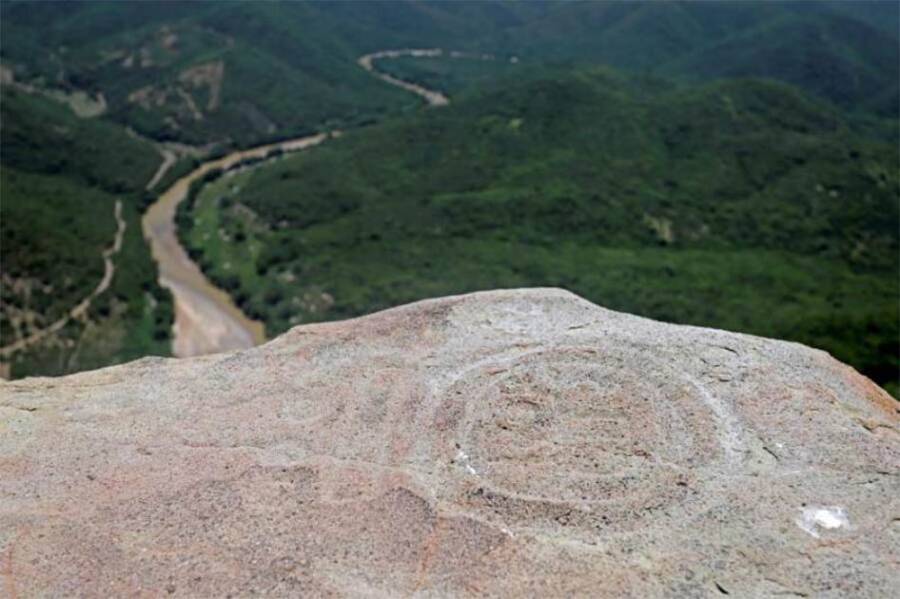The 6,000-foot mountaintop once held temples, the homes of rulers, and a games court.
The southwestern village of Santa Cruz Huehuepiaxtla in Mexico is fairly quaint and remote. At 6,000 feet high, the Cerro de Peña mountain has arguably been its most fascinating landmark. That is, until locals discovered ancient Zapotec ruins and carvings dating back 2,500 years on its summit.
According to the BBC, the find consisted of two pre-Hispanic stone monuments carved into the mountain. Located at a strategic point on the Puebla state mountain’s peak, archaeologists had to traverse a steep, two-and-a-half-hour hike to get there.

FacebookThe 2,500-year-old ruins found on Cerro de Peña include carved stones depicting animals and a woman that resembles a bat.
Built by the Zapotecs, who lived in the southern highlands of Mexico before Spain’s conquest of the region, the site once hosted a ceremonial area, games court, and seven-step pyramids. According to Ancient Origins, the carvings suggest this site was dedicated to the god of the underworld.
Believed by experts to have been hidden since the sixth century, the promising find could shed new light on the history and culture of Mesoamerica before the disastrous arrival of the Conquistadors.
This particular region of Mexico holds a remarkable abundance of ancient ruins and archaeological sites. After making the treacherous climb up Cerro de Peña, researchers from Mexico’s National Institute of Anthropology and History (INAH) excitedly began putting the puzzle pieces together.

The Yucatan TimesTwo etched stone panels, or stelae, were found with carvings that depict animals and figures.
INAH’s José Alfredo Arellanes said this mountaintop site was formerly a ceremonial area that was flanked by temples and the homes of Zapotec rulers.
The games court would have been used to play pelota, a sport with tremendous social and ceremonial value that involved a heavy rubber ball. Similar to basketball, the goal was to toss the ball through a hoop — though players used their hips instead of their hands to do so.

EFEExperts are currently pondering whether or not this female figure that appears bat-like was a goddess.
Alongside the two carved stone panels, or stelae, experts found smaller stones that were also purposefully etched into. Arellanes explained that these were all remarkably well-preserved and that among the wealth of discoveries “87 glyphs, or symbols, have been found so far.”
Some of the depictions are of horned animals and figures, including eagles and iguanas. One of the larger carvings seems to depict a woman that resembles a bat — and could potentially be of an ancient goddess.
The Zapotecs emerged from the Oaxaca Valley and are commonly referred to as the “Cloud People.”
They made their home in the highlands of the continent and established a distinctive writing system. By implementing cultural and religious practices into their social life, they flourished.

EFEModern Zapotec communities exist all over Mexico, with locals claiming they were proud to share their discovery.
These ancients established a substantial state centered on the now-ruinous Monte Alban city more than 2,000 years ago. Zapotec society became so independent that they thrived for centuries and even repeatedly defended themselves successfully against the Aztecs.
The polytheistic religion they practiced saw them worship gods related to agriculture and wildlife, with the now-uncovered site likely an important former hub of religious and ceremonial activity.
Even modern Zapotec believers, whose values have fused with Catholicism, are reverent of the find.

Oro NoticiasIt took archaeologists nearly three hours to scale the 6,000-foot mountain.
The locals who led Arellanes and his colleagues up the mountain said they were proud to have shown them the site, and experts are currently entrenched in an ongoing analysis of the finds. As for the Zapotecs, they were eventually decimated by plagues brought by the Spaniards.
Nonetheless, numerous communities of Zapotec Indians who cherish their lineage remain in modern Mexico — with this discovery sure to mean much more to them than a collection of ancient rocks.
After learning about ancient Zapotec ruins dating back 2,500 years being discovered on a Mexican mountaintop, read about the ancient Mayan palace containing human remains uncovered in Mexico’s Yucatán Jungle. Then, learn about la Cueva de los Cristales, Mexico’s mesmerizing and deadly cave of crystals.





